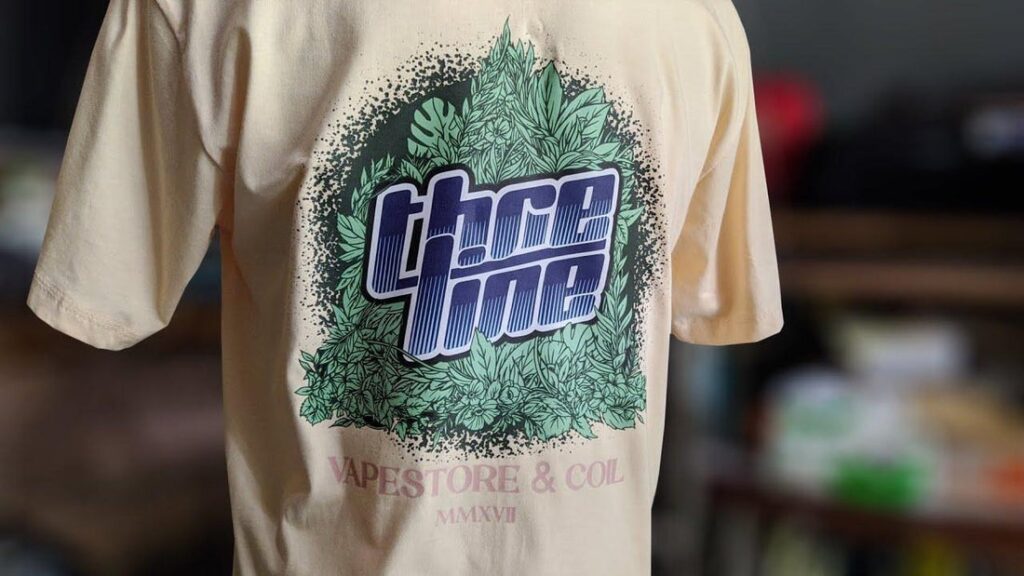Direct to Film, commonly known as DTF printing, is a method used to apply printed designs onto fabrics using a specialised film and heat transfer process. It has become increasingly recognised for its ability to produce clear, detailed prints on a variety of materials.
The technique involves printing artwork onto a film, coating it with adhesive powder, curing the design, and finally transferring it to the chosen fabric using a heat press.
This approach avoids some of the limitations found in older methods and provides a straightforward process suitable for a wide range of applications.
How the Process Works
DTF printing follows several stages that ensure the design bonds correctly with the fabric. The first step is preparing the artwork using graphic design software, where colours, outlines, and details can be managed precisely.
The design is then printed onto a clear or matte film using specialised inks formulated for this process. These inks are typically pigmented and designed to adhere well to the film without bleeding.
After printing, an adhesive powder is applied over the wet ink. Excess powder is removed, leaving only the adhesive that has bonded to the printed areas.
The film is then heated to melt and cure the adhesive, creating a solid surface ready for transfer. Once cured, the film can be placed onto the fabric, and a heat press is used to transfer the design. The heat activates the adhesive and bonds the ink to the fibres, resulting in a durable and flexible print.
Materials Suitable for DTF

One of the characteristics of DTF printing is its suitability for a broad range of materials. It works not only with cotton but also blends, polyester, denim, canvas, and other textiles. This versatility makes the method useful for applications where materials differ from piece to piece. The print can also be applied to both light and dark fabrics without significant adjustments to the process.
Films used in DTF printing are typically designed to withstand high temperatures and maintain stability during the heating stage. Adhesive powders come in different grades depending on the finish required, such as soft hand feel or increased durability.
Benefits in Practical Use
DTF printing is often selected for its ability to capture fine details, gradients, and vibrant colours. Since the design is printed directly onto the film before transfer, the artwork maintains its clarity without requiring multiple passes or layers. The resulting print is usually resistant to washing and general wear, provided that suitable heat and pressure have been applied during the transfer stage.
The method also produces a flexible print that moves with the fabric rather than sitting stiffly on top of it. This is especially relevant for clothing that experiences regular movement or stretching.
Another practical advantage is that transfers can be prepared in advance. Businesses or individuals can print, powder, and cure designs ahead of time and store them for later use. This saves time when producing larger quantities or fulfilling repeat orders.
Design Considerations

DTF printing allows for a wide variety of artwork styles. Illustrations, photographs, typography, and detailed graphics all translate effectively using this method.
When preparing artwork, designers typically consider the resolution, colour profiles, and how gradients will appear once printed on film. High resolution images tend to produce the best results, especially for small or intricate details.
It is also common to include an underbase layer in the artwork. This ensures that colours remain vibrant on darker fabrics and that the final print has an even appearance.
Comparisons with Other Methods
Compared with traditional screen printing, DTF involves fewer setup requirements. Screen printing can be effective for large batches but depends heavily on stencils, colour separation, and manual preparation. DTF printing allows for single prints or varied designs without additional setup, making it adaptable for mixed orders.
Heat transfer vinyl is another common method, but it often requires cutting shapes and layering colours manually. DTF printing places the full design onto the fabric in one step, reducing the chance of misalignment.
Direct to Garment (DTG) printing is effective for cotton-rich materials but may struggle with certain fabrics. DTF transfers can be applied to a wider selection of garments, offering more flexibility.
Applications in Clothing and Textiles

DTF printing is used in many areas of textile production, including casual clothing, uniforms, accessories, and personalised garments. It is also suitable for smaller items such as tote bags, caps, and textile-based promotional materials. Its ability to reproduce detailed artwork makes it useful for hobbyists, designers, and larger production environments.
Exploring Further Resources
Those interested in learning more about the method or viewing related tools and supplies can find further information here: DTF Printing.
Conclusion
DTF printing has become established as a practical and detailed method for transferring artwork onto fabrics. Its structured process, compatibility with different textiles, and ability to handle intricate designs make it widely used in both small and large scale production. With the capacity to store pre prepared transfers and produce consistent results, it continues to play a significant role in the textile and garment decoration sector.

